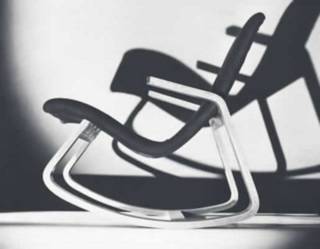
Rapson Rocker - The Rapson Rapid Rocker was designed by Ralph Rapson in 1945 as a part of the Knoll "Rapson Line."
A true modernist, Ralph Rapson is a visionary architect and designer, much admired for his forward-thinking structures and furniture designs. His formal training in architecture began in the early 1930's at the University of Michigan. Upon graduation, he was the recipient of a two-year scholarship to the renowned Cranbrook Academy of Art, led by Eliel Saarinen. Cranbrook exposed Rapson to a variety of art and design disciplines, including painting, city planning, sculpture, photography, graphic design, and textile design. All deeply influenced his later architectural and furniture design projects.In the 1940's Rapson moved to Chicago and joined the New Bauhaus, led by Laszio Moholy-Nagy.
He eventually became head of the architectural curriculum at the highly experimental school. During this period, Rapson gained experience transforming the abstract principles of modernism into concrete structural forms. By experimenting with new technologies and materials in novel ways, he created homes with prefabricated structural elements and 'industrial' mechanisms.
When construction was almost stagnant in the late Depression, Rapson competed in a series of groundbreaking architectural contests. Perhaps the most famous and influential of these was the 1945 Case Study Houses competition for Arts and Architecture magazine. Only 31 at the time, Rapson was the youngest architect invited to enter. Some of the other entrants included such stars of modern design as Charles Eames, Richard Neutra, Eero Saarinen and others.
Rapson's design, the Case Study House #4, married prefabricated construction techniques to sophisticated modern design. It won the acclaim of architects and critics alike, and was widely considered one of the most progressive of all the submissions.
In 1946 Rapson joined the faculty of MIT and eight years later was invited to head the University of Minnesota School of Architecture. Under his direction, Rapson revolutionized the school and led it to national prominence. As a testament to Rapson's teaching abilities, twenty-seven of the forty winners of the prestigious Rotch Traveling Fellowship, between 1950 and 1990, were his pupils.
During the 1950's Rapson was selected by the U.S. State Department to design a series of embassies in Stockholm, Copenhagen and Western Europe. In the post-WWII era, these embassies were significant in conveying the cultural leadership of the U.S. Perhaps his best-known work, the Guthrie Theater in Minneapolis was completed in 1963. An asymmetrical structure with seats placed around a thrust stage, was intended to encourage theatergoers to anticipate "the delight, fantasy, and stimulation of the theater experience itself." Over the last sixty years architecture has weathered many fleeting trends and fads.
Like a rock in the throes of a tempest, Ralph Rapson has maintained an immovable commitment to the basic and best principles of modern architecture. His vision has always been clearly focused on the big picture of architecture – its potential for community betterment and enrichment of the human experience.
<< Home